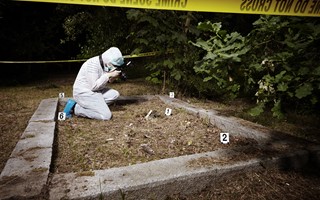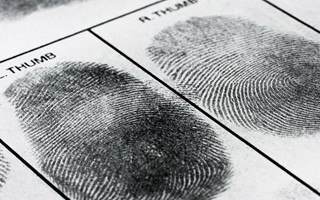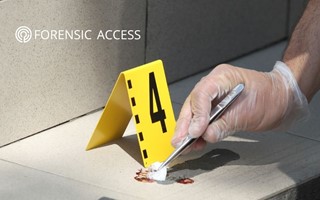News October 05, 2023
James Beard’s recent webinar on Understanding and Challenging DNA Evidence was very well received and we simply didn’t have enough time to answer all the questions that came-up in chat. So we decided to put the unanswered questions to James and other scientists in our biology team for an illuminating DNA Q&A.
What are the limitations of Streamlined Forensic Reports (SFR) and can they be relied upon by defence without further investigation?
The limitations of SFRs are simple, but also critical. They were designed to streamline the investigative and charging processes, they were not designed for use in court. With regards specifically to DNA, the SFR may just be a DNA match report and therefore in many respects it is extremely limited in its usefulness.
The key factor to consider is context. Ask yourself these questions:
- What does this document represent and how does it fit with my client’s defence?
- What item(s) are detailed in the report?
- What does the match state? Is there a statistical figure applied?
- Is the context of how the DNA was deposited relevant?
In this article we aim to help you with the basics, to understand what is being served by the prosecution in the Streamlined Forensic Reports (SFR). Due to the format of an SFR it does not give scope for a full and thorough evaluation or documentation of the evidence. So, we would almost always recommend a full review into the work conducted, as it is important to ensure that all work has been done by the prosecution.
What features do you use to distinguish between primary and secondary DNA transfer?
In short, the factors used in evaluating whether DNA on a surface has been deposited by primary transfer (i.e. direct transfer) or secondary transfer (a two-step indirect transfer) includes the following:
From the DNA result
- The amount of DNA in the recovered sample.
- The nature of the DNA result (assessed by viewing the DNA profile itself).
- The DNA process which has been used.
From the sampled item
- The type of surface the sample was recovered from.
- The size of the area sampled.
- The way in which the item sampled would be handled during normal use.
From the case circumstances
- The differing scenarios put forward by the parties involved.
- The ‘history’ of the item.
- The possible interactions which could feasibly occur.
- An assessment of environmental levels of DNA which may impact transfer issues.
There is also a wealth of research conducted to develop an understanding of what might be expected or given in different scenarios, but there are always limitations in applying data from structured experiments to real world case examples.
If during an evaluation, we reduce the question down to a very simple ‘Was the DNA deposited by primary or secondary transfer?’ then we minimise our chance of answering the question in a balanced and informative way.
The most effective method is to expand the question to include as much information about the suggested scenario as possible. Once a DNA result has been interpreted to assess the source of any DNA, further evaluation of the result with respect to how the DNA has been deposited, must always be done with the result set firmly in context.
Even then, there is no guarantee that an expert will be able to favour one method of deposition above another.
Does the exhibit have a risk of contamination and still suitable for DNA analysis after a Crime Scene Investigator has powered the item for fingerprints?
The item may still be suitable, but this will depend on various factors. Once the item has been examined for fingerprints in non-DNA conditions it has been compromised. It has had a substance added to it and it has also been examined in non-DNA clean circumstances. Therefore, we must consider the limitations of any further analysis within the context of the case.
In considering the ability to obtain a DNA result, the adding of powder or other chemicals may reduce this by destroying DNA, but not necessarily. It may still be possible to obtain a profile, depending on the exact fingerprint treatments used. Therefore, the forensic scientist must find out the techniques used, so the possibility of obtaining a result subsequently can be evaluated.
In considering the issues of contamination (detecting DNA deposited by the examination rather than the investigated incident), any subsequent DNA examinations must accept that the item may have been contaminated. This can include contamination by the brush or other equipment used to treat it, the people carrying out the examination and the environment it has been examined in.
The risk of contamination from the environment or tools used that could transfer DNA from a different item (or case) to the item in question depends on the circumstances of the case. For example, if the item has been screened for fingerprints in the same lab as items from a person of interest, then finding any DNA matching the individual could be contamination. However, if the DNA of the person is not reasonably expected to be within that environment, then it may still be useful to proceed.
The decision to proceed with DNA analysis of the exhibit could be influenced by the type of body fluid or cellular material. For example: if visible blood staining is present then a DNA profile obtained from blood is a more confident sample, thus making contamination far less likely.
Overall, if there is any uncertainty around obtaining DNA analysis from an exhibit that could likely be contaminated, contact our experts. Discussing the feasibility and limitations of the exhibit is important, and only determined on a case-by-case basis.
What are pre-PACE barcodes and how do they impact SFRs?
Pre-PACE barcodes have the prefix 95XXXXXX and below, and PACE samples can either have the pre-fix 96XXXXXX or 3XXXXXXX. Essentially a reference sample which starts with 95 or below should not be used for evidential purposes. However, they can still be requested from the National DNA Database for intelligence only comparisons by the DNA reporting scientist. It’s important to remember that not all SFRs are written by a DNA reporting scientist, so if you have an SFR citing a pre-PACE barcode this must be referred to the originator.
Why do experts combine swabs before examining samples?
There are a number of reasons for combining samples. A scientist typically aims to maximise the possibility of obtaining a DNA profile by combining samples, where there may be small amounts of DNA present. However, there is a balance between increasing the possibility of a result, obtaining mixed DNA profiles and limitations to determine where the resulting DNA profile was obtained from.
How can solicitors determine whether an SFR, without a match probability, is capable of statistical evaluation?
The simple answer is this must be reviewed by a DNA reporting scientist.
Some SFRs may have been written by the prosecution’s DNA scientist however those without a statistical evaluation could be because the police force hasn’t requested or paid for it to be completed.
Support staff members for the police force can also complete an SFR and write the results confirming that the National DNA Database have identified a match between a crime scene item and a reference sample. These latter reports will not have been reviewed by any reporting scientist, and therefore they require appropriate review immediately.
At Forensic Access, we guide you through the nuances of the submission processes and advise you on the best course of action.
What level of detail do you receive from Crime Scene Investigators about the location or source of an item of evidence?
The amount of information received can vary considerably. The scientist carrying out the original examinations for the police should be able to provide information about the location of an item and case circumstances from the reports of the attending officer and Crime Scene Investigator.
They should also understand why the force wants the item examined and any accounts of those involved. In sexual assault cases, a medical examiner’s report and accounts of those involved can be crucial.
It can sometimes be difficult for the prosecution scientist to obtain this information (depending on police forces, contracts, whether a defendant has made an account, and particularly where items have previously been processed in police laboratories), but ideally, they would be provided with this information. The CSI report is usually available to the prosecution scientist at the start of the case and often submitted to the lab with the police request.
When carrying out a defence case review we often have an advantage of more evidential information at that stage, then access to later accounts by defendants or results of other examinations etc. All the information discussed above is necessary to carry out a full review.
CSI reports usually detail what has been examined, sampled and retrieved and can be accompanied by photographs of the stain prior to swabbing or the item at the scene. These can be very useful to determine exactly where was sampled, and the location of the item may assist with queries around indirect transfer of DNA. For example, seeing a blood stain in situ before it was swabbed may allow us to make comment as to how it was deposited originally.
What is the threshold used to identify a ‘true allele’ and how can you confidently differentiate the ‘true allele’ from noise and artefacts in low DNA profile?
Understanding these thresholds allow us to decide when a peak within a DNA result is DNA. This is vital in interpreting DNA profiles.
Every laboratory with a DNA processing line goes through a validation process. This involves testing lots of samples with a known DNA content and having a good look at the results obtained. It is during this process that the laboratory will discern what the various interpretation guidelines are and set the thresholds for reporting scientists to aid them in interpreting DNA profiles.
Therefore, each laboratory will have a set of ‘reporting guidelines’ specific to them and will be constantly reassessed and modified where necessary. These guidelines help scientists to have confidence that what they are seeing is, a ‘true allele’, is DNA from a contributing individual.
There were initial concerns raised surrounding SFR and other types of analysis on the basis that the programming and algorithms supporting the statistical analysis had not been released. Have they been resolved and is there any continuing ‘unease’ about the use of statistical evaluation for mixed DNA on that basis?
Any algorithm used by these programs have been published, peer reviewed, validated and accredited by UKAS and some are used and accepted by the courts worldwide. The amount of industry debate surrounding the methods used means that our concerns around the statistical methods are greatly reduced.
However, the interpretation of results is not only reliant on the algorithms used but equally on the validity of the assumptions made when setting hypothesis. We regularly observe the setting of inappropriate hypothesis, particularly around the number of contributors as new information comes to lights during the defence evaluation. Therefore, reviewing these results can still be critically important.
What is the margin of error when using SGM, SGM+ and DNA17?
The profiling test itself is run with set controls. If the controls pass, then any clear DNA components detected that meet the reporting criteria are designated as a particular component with no margin of error. This would apply to SGM, SGM+ and DNA17. This means determining the actual clear components detected in a result is robust with no error margin.
SGM+ looked at 11 areas of a person’s DNA. DNA17 looks at those 11, plus 6 more. Therefore, DNA17 is a more discriminating technique. If an SGM+ profile was obtained from a sample and matched a reference profile at all 11 areas a statistic of over a billion would be quoted. If DNA17 profiling of the sample and reference showed a difference at one or more of the extra areas, then that person would then be excluded as having left the DNA. This does not mean the SGM+ result was an error but shows that we now have more information.
If a person matches at all 11 SGM+ areas of a non-mixed full DNA profile, then it is highly unlikely that DNA17 profiling would eliminate them. It is however far more likely to further confirm the match. The exceptions to this would be when dealing with complex mixed DNA results, or any possibility of related individuals. In these cases, a DNA17 reference sample should be obtained to allow a fuller comparison.
Is there a time limit for challenging an SFR?
Yes, and this wording is extracted from an SFR: If the DNA evidence is not accepted by the defence, then this SFR1 must be challenged, either on the basis that you dispute the DNA match, or another reason, for example you dispute the mechanism of transfer of DNA. In accordance with Crim.PR 19.3(2), the defence is required to serve a response to this report as soon as practicable, and in any event not more than 14 days after service of the SFR1.’
Whether this timeframe is routinely adhered to, or enforced, is open to discussion.
When will it be possible to age someone from their DNA?
It would be wonderful to use DNA to age people, but this is an unlikely to be an option available to us anytime soon. While there are limited changes to our DNA as we age, none of these are tested using the methods available to forensic scientists and could never be able to accurately predict a person’s age from their DNA.
Is there a test for vaginal fluids?
In short, the answer is ‘no’. There have been some attempts in the past to identify vaginal material, such as ‘Lugol’s Iodine’ test or by assessing the characteristics of the nucleus within the cells found in vaginal secretions, but these have been shown to be unreliable and not been used for some time.
There is no accredited test currently used by forensic science providers in the UK. Research is always ongoing to look at new ways of identifying body fluids, and some of the work with ‘messenger RNA’ (mRNA), a component of a cell’s genetic processes does looks promising, so who knows what might be available in years to come?
Don't miss out on the evidential opportunities DNA can provide to your case. Work with our casework management team to effectively delegate, save time and strengthen your defence strategy. Contact us at science@forensic-access.co.uk or (+44) 1235 774870.


